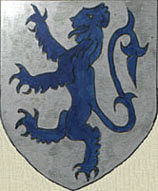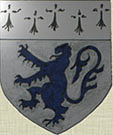The rate of one shilling and threepence in the pound when £1 = 240 old pence is equivalent to 6.25 pence in the pound when £1 = 100 pence.
BUY TO LET AND GET RICH.
Out of 955 houses only 130 were owner occupied.
The greater part of the population lived in the streets of terrace houses which had been built in the last decades of the 1800's to rent to the ironstone miners and their families.
Few of these has been bought by the occupant and whole streets and blocks of houses had been built by individuals for rental income.
It is reasonable to assume that this proportion of house ownership was typical of all the many mining communities in the North East of England.
In Skelton the whole of Park Street, for instance, had been erected for Bell Bros & Co, who owned, in addition to other mines, steelworks and property, both Shaft and Park pits,
where most of the miners worked.
The average wage at that time for miners was 3 to 4 shillings per day.
Rents were over £6 per annum and rates over 6 shillings.
So the mineowners were giving wages to their workforce with one hand and taking it back with the other.
Men had to toil for some 40 days per year to clear this outgoing before they could think about feeding and clothing a wife and often ten or more children.
Similarly we can see that Dixon Street obtained its name from the family who owned the first block of houses.
At one time the whole of Skelton was owned by the occupant of Skelton Castle and in 1913 the Squire, William Henry Anthony Wharton still held 250 buildings and pieces of land.
In addition to this large rental income he also received a percentage of every ton of ironstone that was raised on his land.
An exception to this pattern of terrace houses being rented was Bolckow St at North Skelton, which had slightly better class houses, all of which were owned by the occupiers, who were Mine Managers and the like.
The Ironstone Mine Owners, the NE Railway Co, the new Gas, Electric and Water companies all paid into the Parish coffers.
Their contribution made up a third of the total £3,250 collected and the bulk of this surprisingly was paid by the mine owners on the ironstone raised at the rate of 7.5 old pence in the pound. [See page 5 below.]
The rate book reveals that the local territorials, G Company of the 4th Battalion, The Yorkshire Regiment, had an armoury at 93-95 High St and a Rifle Range at High Park, but no mention of the new Drill Hall that was opened
behind Yeoman St in this year.
The horse was still the main form of transport and there are several entries for rates being paid on wooden stables.
|
 |
From Elizabethan times up to the creation of the Workhouses in 1834 the main function of the Parish Rates had been to provide relief for the poor and destitute.
Each Parish had by law to elect Overseers to administer this system.
[See here for Skelton Overseers and the Rate Book of 1822.]
In 1913 people who could not provide for themselves were still sent to the Workhouse 4 miles away in Guisborough.
Presumably each Parish still had to contribute to the running of this Institution, but ratepayers had by now to pay for other public services.
There were "Skelton Township" offices at 54 to 56 High St to administer these new functions, but we can see from the rate book that Overseers were still elected.
Four "Overseers of Skelton Parish", A Tate, W Hawthorn, William Wilkinson and N Teasdale affirm that the rate collection procedure has been carried out according to provisions of the 1862 Rate Assessment Act.
|
|
The pages below show information for the Skelton villages only, omitting Boosbeck and Lingdale which were also part of Skelton Parish.
Payment details are also left out and only the rateable value of properties given. [Full details can be seen in the original book which is preserved by Teesside Archives, Middlesbrough.]
|
CLICK ON ANY PAGE NUMBER BELOW TO OPEN IT.
Page 1
Castle, Corn mill, Home & Barns Farms, Kennels etc.
Page 3
Back Lane, Milbank St, Prospect Place.
Page 5
North, South, Longacres Mines, Hagg & Wet Furrows Farms etc
Page 7
Harker St, Park St.
Page 9
Park St, Shaft & Park Pits, Rawcliffe Cotts etc.
Page 11
Blacksmiths, workshops, butchers etc
Page 13
Various business premises etc.
Page 15
Farms - Priestcrofts, Hobdale, Fogga, Holly Bush etc.
Page 17
Back Lane.
Page 19
Wharton St, Richard St North Skelton.
Page 21
Bolckow St, Vaughan St, North Skelton.
Page 23
William St, Wharton St, North Skelton.
Page 25
William, Richard St, North Skelton.
Page 27
John St, Charlotte St, New Skelton.
Page 29
Thomas St, Stanghow Rd, New Skelton.
Page 31
Woods Yd, Green Rd, Back Lane.
Page 33
Boosbeck Rd, Trout Hall Lane, Skelton Green.
Page 35
Cleveland St, Harker St, Skelton Green.
Page 37
Robinsons Yd, High St, Cravens Yd, Tates Yd.
Page 39
High St.
Page 41
Dixon St, Yeoman St.
|
Page 2
N, S, West Tces, Marske Lane, Drill Hall, Halfpenny Bridge etc
Page 4
Prospect Pl, High St, Band Room, Rifle Range etc
Page 6
HowlaHay & Back Lane Farms, Harker St, Ellers Cots etc
Page 8
Park St.
Page 10
Schools, Phones, Gas, Inns, Clubs, Hippodrome etc.
Page 12
White Hse, Rigwood, Rushpool, Farms etc.
Page 14
Charlotte St, Farms Skelton Green etc
Page 16
Green Rd, High St, Elliot St, E Parade etc.
Page 18
N E Railway Co.
Page 20
Ground Hill.
Page 22
Vaughan St, Wharton St, William St, North Skelton.
Page 24
Wharton, William St, North Skelton.
Page 26
Richard St, Holme Beck Rd, North Sk. John St, New Skelton
Page 28
Charlotte St, Thomas St, William St, New Skelton.
Page 30
The Hills, South, North & East Tce, Rectory, Woods Yd.
Page 32
Boosbeck Rd, Skelton Green.
Page 34
Trout Hall Lane, Elliot St, Cleveland St, Skelton Green.
Page 36
Harker St, East Parade.
Page 38
High St.
Page 40
High St, Robinson St, Dixon St.
Page 42
Yeoman St.
|
|



